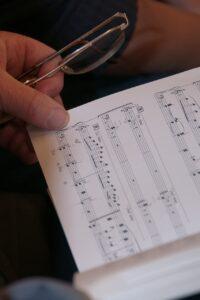Estimated reading time 5 minutes
Table of Contents
Introduction
Do you have a hard time singing with a strong vocal tone? Do you want to be able to sing in tune? Controlling how you sing vowels will help you get a stronger tone and give you the tools to sing in tune. We’ll focus on tongue vowels today, because you’ll find tongue vowels easier to produce than lip vowels. Read more to learn about singing tongue vowels.
How important will vowels be to your tone and intonation? According to Gerald Eskelin, “If there is one component more important to vocal blend than all the others, it is surely vowels.
“While good intonation is vital to good blend, pitch agreement is very difficult to achieve when singers disagree on vowel focus.
“Once vowel is in agreement, intonation improves with little effort” (Components of Vocal Blend 13).
The first post in our vowel series, Sing Schwa Vowels, talked about how to produce the shwa (uh). Also, it discussed how to “sing into the mask,” which helps to strengthen the tone of any vowel.
Today we’ll talk about tongue vowels. What are tongue vowels? Read the next section to find out.

Speaking and Singing Tongue Vowels
Before you start singing tongue vowels, we need to look at how tongue vowels work. Click here for a chart with vowel audio samples.
Click on each audio sample on the left side of the chart above. From bottom to top you’ll have: a (bath with a New England accent), a (bat), eh, ih, ay, ee.
Phoneticians use the term front vowels for these phonemes. They ascend on the chart from open to closed.
However, John Moriarty, the author of Diction, feels that these will be bad terms for singers to use. Because open, closed, front, and back could lead vocalists to sing with collapsed soft pallets, he instead suggests we use the term tongue vowels. Tongue vowels consist of vowels that you produce by raising and lowering your tongue – thus the name.
Singing Tongue Vowels: Flexible Pitch and Flexible Vowels
The notes you sing won’t be constrained to the 12 notes of the piano. As a vocalist, you have the flexibility to sing each “piano note” along a continuum of multiple pitches. (For more info on the research on flexible pitch tuning, see the post A Note Contains Many Pitches.)
Likewise, the vowels on the chart can be adjusted along a range of spectral tone color as well.
Eskelin offers this advice, “The words on the chart are to be considered reference points along a continuum, not as ‘correct’ placements.
“Each reference word locates a point of vowel sound relative to other points. Since spoken language uses a great number of subtle vowels adjustments, the number of reference words used on the chart is quite arbitrary.
“Many more ‘standard’ words could be added but this might tend to clutter rather than clarify” (14 – 15).
You can adjust your pitch to become better in tune, thus making a vowel sound stronger and more vivid. However, you can also adjust your vowel to strengthen the tone color of a specific pitch. (For more info on the science behind how harmony affects your vowel tone color, see Harmony is Tone Color.)
Thus, you can adjust both factors to create the best vocal tuning and tone quality. How do we do this in practice when singing tongue vowels? Read the next section to find out.
Vocal Exercises for Singing Tongue Vowels
The Vocal Track
Most of The Intonation Flight Simulator posts focus on adjusting your pitch to sing in tune. In Singing Tongue Vowels, you’ll focus on adjusting your vowel while holding a steady pitch. The example below has two C (or Do) notes that you’ll hold for a long time. (For a discussion of shape notes, see Shape Note Sight Reading Success.)
You’ll sing the vocal drills with the synthetic vocal track below, which has a special tuning to help you achieve good vocal intonation.
Moreover, the sing-along tracks use synth voices rather than actual voices. Science has shown that this helps you, the vocalist, to identify and perform absolute pitch information. For more info, see Why Use a Synth Voice Instead of Real Voices.
The Exercise
Start by singing the tongue vowel ee. Gradually switch from the ee sound to an ay sound by dropping your tongue and jaw.
Do it slowly enough so you can hear all the “vowel” sounds in between but complete the transition before the note changes in bar three. When you stop at ay, try to find the version of ay that best fits the note and harmony. When you find it, the tone will be vibrant and strong.
Make sure you don’t change your pitch as you make the vowel transition. Also, Eskelin suggests you place a finger over your lips. That way you can focus only on changing the vowel through tongue adjustments and not through lip adjustments.
Next, try the exercise again, but now transition between ee and ih. Your tongue will drop lower for ih than it did for ay. Then, continue this exercise for all the vowels on the left side of the chart.
After that, start at the bottom of the chart and work your way up. Finally, you can mix it up, working on any vowel transition you want from the left side of the chart.
Mobile users: for best results reading the music, tilt your screen 90o to the right.


Synthetic Voice Track:
Singing Tongue Vowels: Posts that Help with Vocal Intonation
- Sing Shwa Vowels: This post introduces the “vowels” series of posts.
- The Intonation Flight Simulator: This link has posts with song tracks that you can sing along with. The song tracks’ special tuning helps you achieve good vocal intonation.
- Sing in Tune Like a Rock Star: This post works on the skills to help you emulate vocal timbre and nuance.
- 10 Elements that Impact Vocal Tuning: This post discusses the most important factors that affect vocal tuning.
- Singing with Power: This post section talks about singing with a supported tone, which aids vocal tone and intonation.

Concluding Thoughts on Singing Tongue Vowels
In future vowel posts we’ll talk about lips vowels, diphthongs (such as w, I, U, ow, oi), and the R “vowel.”
The more you practice singing tongue vowels with the sing-along song track, the quicker you’ll master the skills you need to sing in tune with a strong tone. Have fun!
© 2022 Geoffrey Keith
Join me for in-person or online lessons today!
How Do I Switch from Chromatic Shaped Notes to Standard Notation – Part 3
Do you want to learn how to transition from shape notes to standard notation? Have you ever wondered when you should use the special solfege syllables for sharp and flat notes? Standard notation gives you clues on when to use the diatonic solfege syllables versus the chromatic syllables. Read more to learn the answer to the question, “How do I switch from chromatic shaped notes to standard notation?” Estimated reading time 2 minutes.
Read MoreEar Training Exercises for Harmonizing in Tune
Want to be able to sing like your favorite vocal group? Today we will get to the heart of our ear training exercises. Singing with the sing-along sound tracks fosters a cappella level vocal tuning. Also, the post talks about vocal air flow. Estimated reading time 3 minutes.
Read MoreWhy Can I Play Piano Hands Together but not Separately?
Do you ever find yourself asking, “Why can I play piano hands together but not separately?” Really, it depends on the type of music you play. Some pieces lend themselves to hands together work, while others will be better suited for learning hands separate. Click to learn the factors that impact how you learn a new piece of music. Estimated reading time 2 minutes.
Read MoreA Harmony’s Length Impacts Singing in Tune
Does singing in tune seem like a mystery with no clues? Knowledge is power. Read more to find out how a harmony’s length impacts singing in tune. Estimated reading time 7 minutes.
Read More




